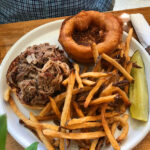After discovering invasive species over-taking parts of the campus forest, Asheville School decided to use alternative methods to take a bite out of the problem.
In 1997, forester Rachel Wood conducted a study about Asheville School’s forest. She developed the 1997 Stewardship Plan. A decade later, Asheville School hired Mony Wooten to conduct a study about the school’s 200 acres of natural woodland. The 2007 study determined that there was an alarming amount of invasive species growing around the tress and “choking” out the forest. Wooten suggested using herbicides, a controlled burn, or goats to fight back against the invasive plants.
Members of Asheville School’s Students for Environmental Awareness (SEA) discussed the options, and decided to try the least toxic approach: goats. Wooten was able to connect the School with Wells Farm — a local farm that rents goats just for this purpose.
Wells Farm provides an environmentally safe method for clearing areas containing invasive vegetation. Controlled herd grazing provides an ecologically sustainable method of land management, according to the Wells Farm website.
Using goats is cost effective, environmentally safe, and are less noisy and more efficient thanheavy machinery. The goats also naturally fertilize the ground and keep it well aerated.
Asheville School had 45 goats grazing the campus from July 24 – October 11. Students in SEA and a freshman service group are involved with this experiment.
“We picked goats because the alternatives were burning or chemical treatment-both of which could potentially have more severe adverse impacts. Insurance also would not smile upon controlled burning,” said Rebecca McKee ’10.
Now a freshman at Davison College, McKee hopes to help to control invasive species on her college campus. While at Asheville School, she was president of SEA. She and Controller and SEA leader Michelle Lewis maintained the goats during the summer.
“SEA has five monitoring plots (approx. 1/10 of an acre each) throughout our forest that we collect data on in the fall and spring of each year. One of the plots is within the goat area and was originally chosen because of the abundance of invasive plants. We will monitor how the goats have affected the area once theflora starts to come back in the spring,” said Michelle Lewis.
Also, the club is discussing different options for experiments within separate sections of the goat area (which totals about 5 acres) including: pushing up brush with a tractor, manually cutting back the exposed weeds with pruners, spraying herbicide in controlled areas, or doing nothing beyond what the goats have done.
SEA club members participated in a Global Work Party in October of 2010 to manually cut back weeds that the goats stripped. The group included Angie Macias, Bill Wheatle, Taylor Jeffries, Parker White and Katharine Harvard as well as Joanne Crotts and her daughter, Jillian.




















Finally someone takes some good Advice, I have talking about how goats are wonderful for this exact thing. I never spoke to them but bravo for this!!